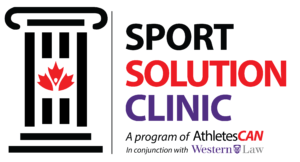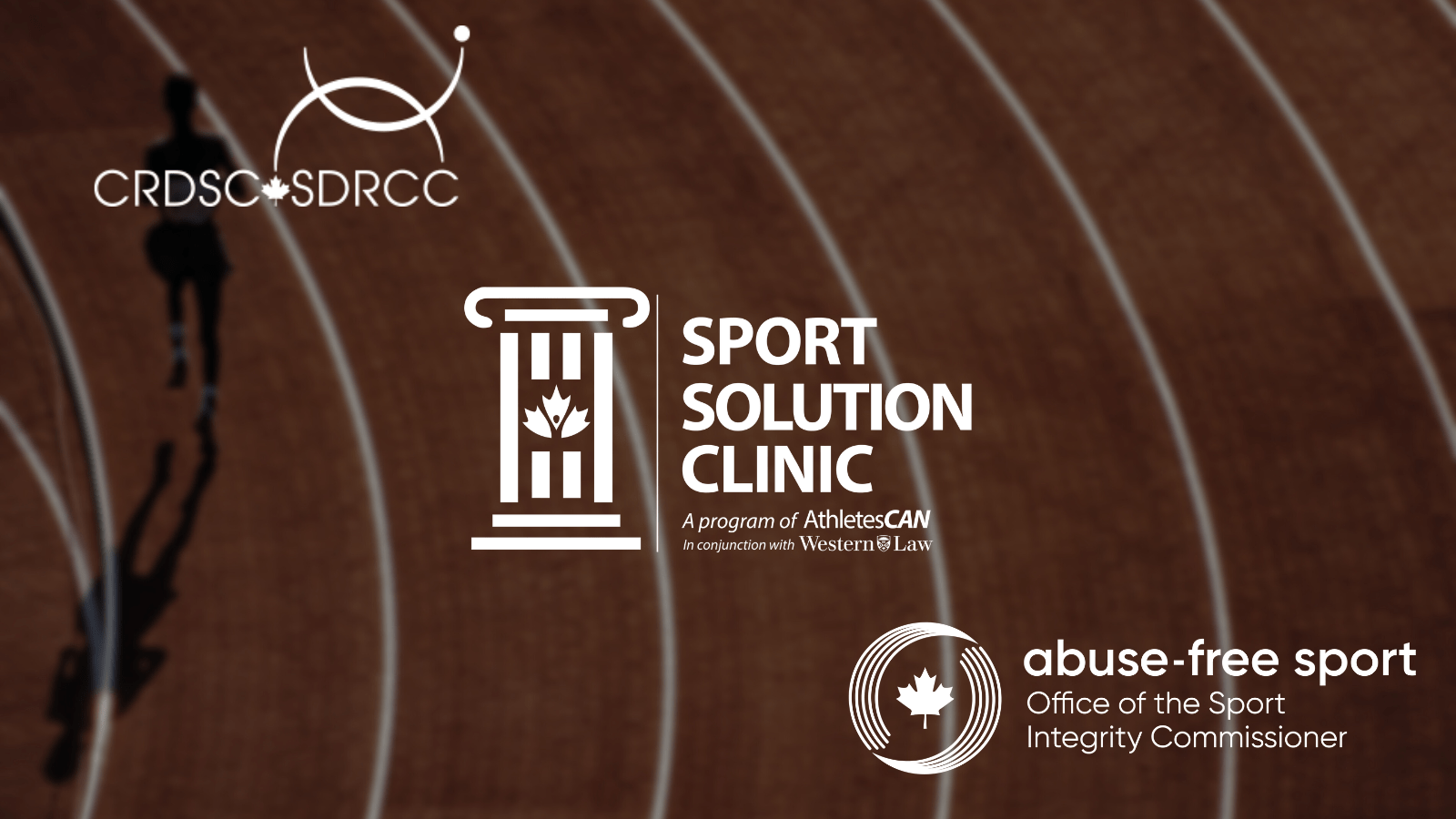By Tyler Rogerson (Case Manager), Isabella DiMenna (Caseworker), Nicholas Burton (Caseworker)
The Sport Solution Blog is written by law students and is intended to provide information and the team’s perspectives on current issues. However, the Blog is not intended to provide legal advice or opinion. Athletes in need of assistance should contact the clinic directly at [email protected].
Key Takeaways
- Provides an overview of the different administrative bodies and stakeholders that govern and regulate national-level sports in Canada
- Outlines the legal resources that are available to members of AthletesCAN
Canada’s National Team athletes are busy! Between training, competitions, recovery, and finding time to decompress, AthletesCAN members have demanding schedules. To make matters more complicated, Canadian athletes may be faced with legal challenges throughout their career. These issues may include disagreements over team selection, concerns regarding Athlete Assistance Program funding, Safe Sport disputes, and disagreements over disciplinary measures.
This blog post will provide Canadian athletes with an overview of the various administrative bodies that govern and regulate high -performance sports in Canada and how they interact with one another. Ultimately, Canadian athletes should know that the Sport Solution Clinic at Western Law exists to provide all members of AthletesCAN with pro bono (free!) legal advice and representation and can assist them in the resolution of their sport-related legal issues.

The Sport Dispute Resolution Centre of Canada (SDRCC)
The SDRCC is created by the Physical Activity and Sport Act,1 and provides alternative dispute resolution for sport-related disputes in Canada.2 In essence, the SDRCC is an administrative body that is responsible for mediating and arbitrating sport-related disputes involving Canadian national team athletes; however, the SDRCC will only become involved after the disputing parties have exhausted their sport’s internal dispute resolution processes. All disputes submitted to the SDRCC are governed by the Canadian Sport Dispute Resolution Code (the Code) which “outlines the procedural rules under which all disputes submitted to SDRCC must [adhere to].”3 The most recent version of the Code (which applies to all SDRCC cases opened after 1 October 2023) can be found here and will be useful for any member of AthletesCAN who would like to bring a dispute to the SDRCC.
The SDRCC offers four different dispute resolution methods: resolution facilitation, mediation, arbitration, and mediation/arbitration.4 Resolution facilitation involves a neutral facilitator “whose role is to try to help the parties to better communicate with each other and to resolve their dispute through an amicable settlement.”5 Similarly, mediation involves a neutral third party who focuses on facilitating a resolution between disputing parties rather than on promoting communication. Mediation will only end a dispute if the disputing parties agree to a resolution.6 The process of arbitration, however, is significantly more structured and “employs a neutral third party to hear the evidence and decide for the disputants how their conflict should be resolved.”7 It is important to note that resolving disputes by arbitration will not be collaborative and the arbitrator’s decision will only favour one of the parties.8 Lastly, mediation/arbitration is a hybrid dispute resolution mechanism that may ultimately result in arbitration. In this mechanism, both parties are given the opportunity to first resolve their issues through mediation. If the mediation process is unsuccessful, both parties will be required to have their dispute resolved by arbitration.9
Beyond its role as an administrative tribunal, the SDRCC aims to educate Canadian national team athletes and provide them with the “tools and guidance to help resolve minor disputes quickly and informally.”10 The SDRCC is committed to proactively connecting with key stakeholders in the AthletesCAN community through the publication of resources, hosting of workshops, and the distribution of educational material about how to best prevent and resolve disputes at the lowest levels.11
For more information on the SDRCC, please visit the SDRCC website.

The Office of the Sport Integrity Commissioner (OSIC)
The Office of the Sport Integrity Commissioner is an independent division of the SDRCC which aims to promote Safe Sport and implement the Universal Code of Conduct to Prevent and Address Maltreatment in Sport (UCCMS) across Canada.12
The UCCMS was first published in 2015 and “is the core document that sets harmonized rules to be adopted by sport organizations that receive funding from the Government of Canada to advance a respectful sport culture that delivers quality, inclusive, accessible, welcoming and safe sport experiences.” 13All sporting organizations that have adopted the UCCMS are held accountable by the OSIC to ensure that their sporting environments are free of misconduct and are spaces where all community members are treated “with dignity and respect.”14
The OSIC enforces the UCCMS in two ways: complaint management and through Sport Environment Assessments. The complaint management process focuses on individuals and involves receiving complaints, conducting initial assessments and independent investigations, imposing sanctions, and providing access to legal and mental health support.15Through its complaint management system, the OSIC has established a mechanism for members of the AthletesCAN community to ensure that they can report and address instances of maltreatment and misconduct.16
Sport Environment Assessments are broader in scope than the complaints handled by the complaint management process. The Assessments aim to investigate and address systemic issues of maltreatment and misconduct which contravene the UCCMS in a particular sport. Sport Environment Assessments are intended “to look for the truth, seek to understand the problem and its root causes, and then look at possible solutions, all of which are ultimately presented in a published report.”17
Both the complaint management and Sport Environment Assessment processes are designed to complement one another and aim to achieve the same fundamental goal of eliminating maltreatment and abuse within Canadian sports and ensuring compliance with the UCCMS.18
For more information on OSIC, please visit the OSIC Website.
National Sport Organizations (NSOs) and Provincial/Territorial Sport Organizations (PTSOs)
National Sport Organizations (NSOs) are “the national government bodies for [a] given sport in Canada.”19 At the time of the publication of this blog post, there are 63 federally-funded NSOs in Canada. Although they have many important functions, NSOs manage their sport’s high -performance programs, select their sport’s National Team(s), and manage the promotion of their sport across the country.20 Further, NSOs can directly assist athletes through the Athlete Assistance Program which supplies government funding directly to Canadian athletes nominated by their NSOs.21 A full list of the NSOs can be found on the Government of Canada website.
Notably, many NSOs have provincial and territorial counterparts, Provincial/Territorial Sport Organizations (PTSOs), which have similar functions to NSOs. An athlete can interact with both their NSO and PTSO at different stages of their career and may even interact with both administrative bodies simultaneously. Due to the significant role that NSOs and PTSOs have in the development, mentoring, and success of their athletes, legal issues can arise between the parties over team selection, funding, and disciplinary measures. It is at this point that the parties may rely on the intervention of the SDRCC and the OSIC and members of AthletesCAN may turn to the Sport Solution Clinic for legal advice and representation.
Ultimately, NSOs, PTSOs, and athletes must work collaboratively within the guidelines of the SDRCC and the OSIC to advance the success of their respective sports and the safety of their sporting environments.

Western Law’s Sport Solution Clinic
Western Law’s Sport Solution Clinic provides pro bono (free!) legal advice and representation to Canada’s National Team athletes. The Sport Solution Clinic is unique as it is the “only program of its kind in North America and is available to all members of AthletesCAN.”22 The Clinic is dedicated to assisting Canada’s national team athletes in navigating the myriad administrative bodies and systems that govern their sports and provide access to the legal remedies available to them.
The Clinic is supervised by its Supervising Lawyer, Amanda Fowler, and is supported by a staff of 25 students at Western Law. Together, the team at the Sport Solution Clinic provides legal support on a wide variety of legal issues including general inquiries, team selection, Athlete Assistance Program funding, appeals, Safe Sport, discipline disputes, and preparation for mediation and arbitration through the SDRCC.
Ultimately, the Sport Solution Clinic exists to provide free legal assistance to Canada’s national athletes so they can focus on their sporting pursuits and reach their goals on the world’s biggest stages. For more information on the Sport Solution Clinic, please visit the Clinic’s website or contact us at [email protected].
Footnotes
- SC 2003, c 2.
- Ibid, s 10(1)(a).
- Sports Dispute Resolution Centre of Canada, “Dispute Resolution Secretariat (Tribunal) – Code” (last visited 24 October 2023), online: <crdsc-sdrcc.ca/eng/dispute-resolution-code>
- Sports Dispute Resolution Centre of Canada, “Dispute Resolution Secretariat (Tribunal) – Dispute Resolution Services” (last visited 22 October 2023), online: <crdsc-sdrcc.ca/eng/dispute-resolution-facilitation>.
- Ibid.
- Ibid.
- Ibid.
- Ibid.
- Ibid.
- Sports Dispute Resolution Centre of Canada, “About – Mission” (last visited 22 October 2023), online: <crdsc-sdrcc.ca/eng/about-mission>.
- Sports Dispute Resolution Centre of Canada, “Resources” (last visited 22 October 2023), online: <crdsc-sdrcc.ca/eng/dispute-resource-publications>.
- Office of the Sport Integrity Commissioner, “About – Vision” (last visited 22 October 2023), online: <sportintegritycommissioner.ca/vision-mandate>.
- Office of the Sport Integrity Commissioner, “Universal Code of Conduct to Prevent and Address Maltreatment in Sport” (31 May 2022), online (pdf): <sportintegritycommissioner.ca/files/UCCMS-v6.0-20220531.pdf>.
- Ibid, s 2.2.
- Office of the Sport Integrity Commissioner, “Process Overview” (last visited 22 October 2023), online: <sportintegritycommissioner.ca/process/overview>.
- Ibid.
- Office of the Sport Integrity Commissioner, “Sport Environment Assessments FAQ” (last visited 24 October 2023), online: <sportintegritycommissioner.ca/sea-faq>.
- Ibid.
- Government of Canada, “National Sport Organizations” (last visited 3 March 2022), online: <canada.ca/en/canadian-heritage/services/sport-organizations/national.html>
- Ibid.
- Government of Canada, “National Sport Organizations - 2021/2022 Funding” (last modified 23 August 2022), online: <canada.ca/en/canadian-heritage/services/sport-organizations/national/funding.html>.
- Western Law, “Sport Solution Clinic” (last visited 22 October 2023), online: <law.uwo.ca/legal_clinics/sport_solution_clinic/index.html>.
